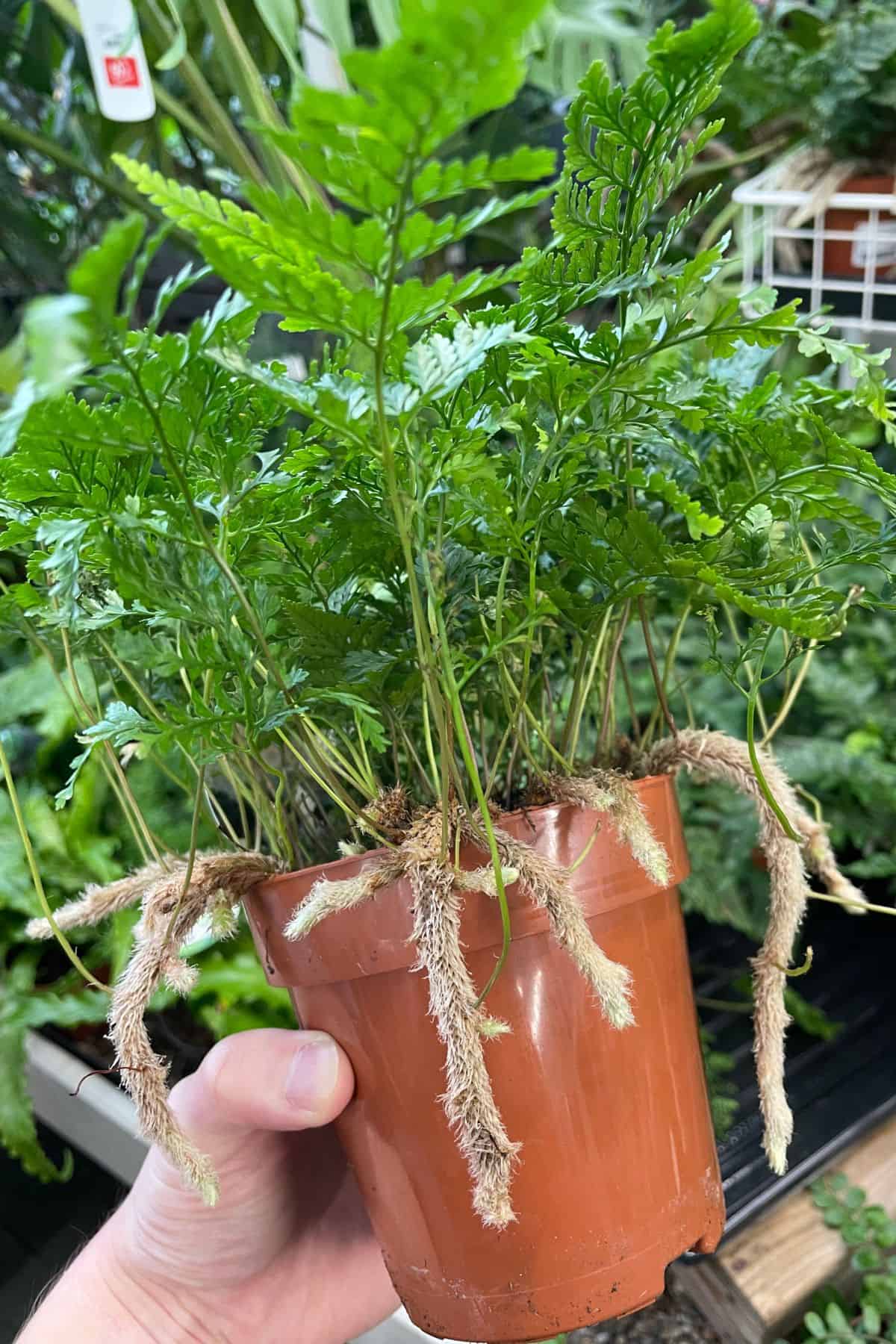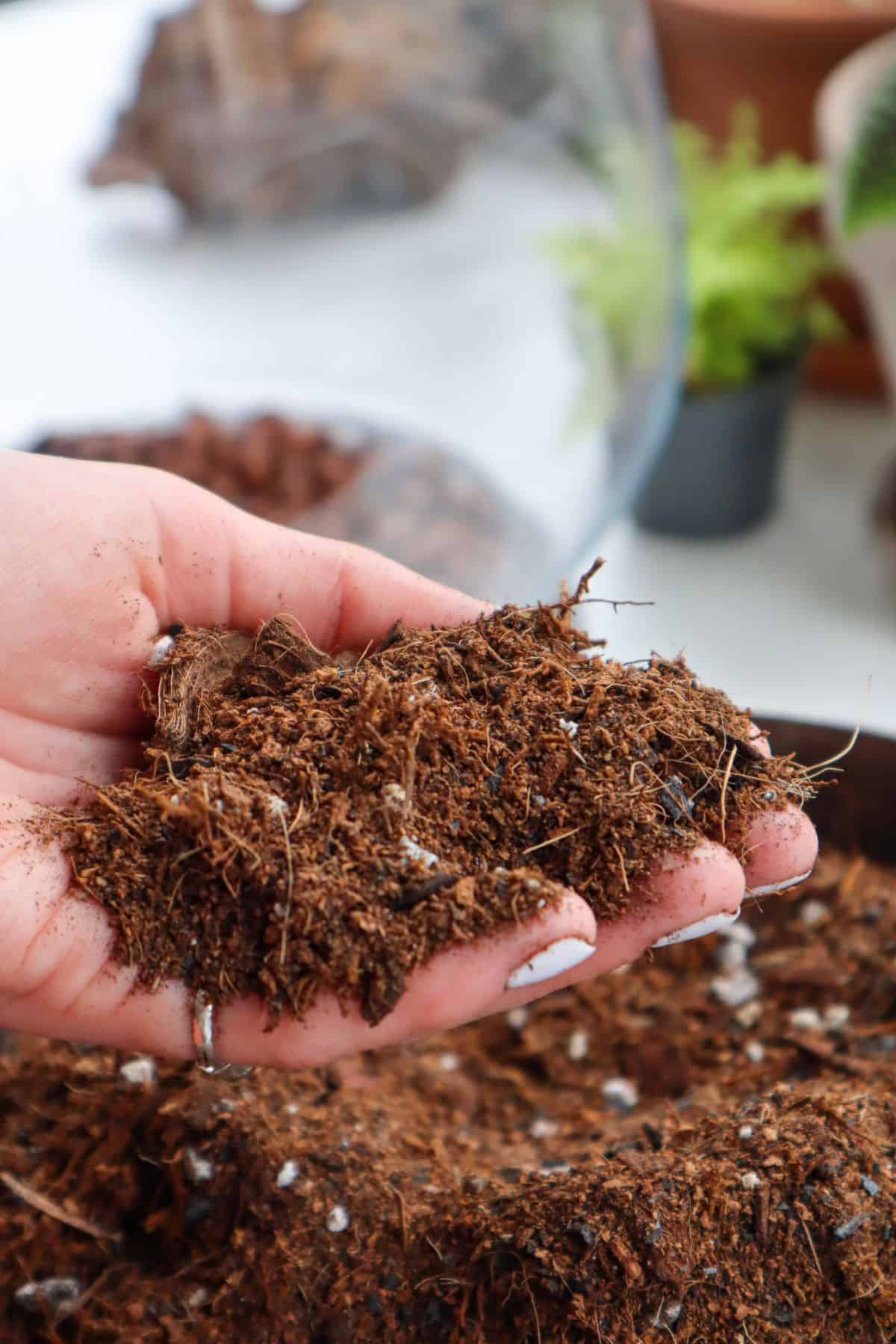Davallia fejeensis is a common variety of the popular Rabbit’s Foot Fern – and true to its adorable namesake, it serves plenty of fluff and fur.
Interestingly, the name doesn’t come from its bushy, bright-green fronds. It comes from its fuzzy cream rhizomes that spill out over the pot and look distinctively like little rabbit paws!
With such fancy fur accessories and a name like Davallia fejeensis (which gives TOTAL drag queen energy), you’d expect this plant to be somewhat of a diva.
But when you know how to treat it right, it’ll be as cute as a bunny.
So, without further ado, let’s hop to it.

What’s the Deal With Davallia fejeensis?
Native to tropical regions of Asia, Oceania, and Africa (with this specific species coming from Fiji), the Rabbit’s Foot Fern is a versatile plant, to say the least.
In the home, it’s a reliable terrestrial houseplant. But in its native environment, Davallia fejeensis actually thrives when established epiphytically in the nooks and crannies of trees.

It’s worth noting that the fejeensis is not the only species sold under that common name, but they’re all pretty similar.
If you were to purchase a Rabbit’s Foot Fern (often, these plants are just sold as unspecified Davallia plants), you could be getting the equally common Davallia tyermannii or any one of the 40-60 species in the Davallia genus.

Where to Buy Rabbit’s Foot Fern
See the links below to purchase from reputable terrarium plant shops and marketplaces (may include affiliate links).
Davallia fejeensis Care & Growth
| Plant Type | Fern |
| Lighting | Medium – high indirect light |
| Temperature | 60-75ºF (15-24ºC) |
| Watering | Regular, even moisture |
| Humidity | High humidity (60-90%) |
| Growth | 10-24 inches |
Lighting Requirements
A typical fern, the Rabbit’s Foot Fern grows best under bright but indirect light.
It should do alright in lower light conditions (within reason), but direct sunlight can easily scorch the leaves and turn the rhizome into a deep brown color.
To best avoid this, keep her on a North or East-facing windowsill. If you only have South or West-facing windows available, keep her several feet away.

I’ve been keeping my plant in an East-facing room & it’s been very happy there.
How to Water Davallia fejeensis
As you know, this versatile plant can go both ways.
If Davallia fejeensis is planted terrestrially in soil, it’ll need regular, even moisture. This fern has very shallow roots and takes most of its water from the topsoil and stores it within its rhizomes.
But, as you’d expect from a plant that can be epiphytic, it cannot withstand being sat in soggy soil. So, the key here is moisture; we don’t want this plant to be wet. Good drainage is essential.

Yellowing leaves (well, fronds) are usually a sign of Davallia fejeensis needing more moisture. Increase the humidity or the watering frequency to nurse your plant baby back to health.
Best Soil/Substrate
A suitable soil for a Rabbit’s Foot Fern must be able to retain moisture well, as the shallow roots won’t reach far in search of it.
You could make your own mix using coco coir as a spongey base, adding earthworm castings for organic fertilizer and a chunky material for drainage. Our tropical mix contains all of the above, with orchid bark and optional pumice.
But honestly, any high-quality fern mix will work a treat.

In a terrarium or vivarium, it will happily grow on most surfaces, including wood and rock, as long as there’s moisture to be found. Though size is more likely to be the limiting factor here, I found it was a bit too large a species to plant this way, so I’d stick to planting terrestrially unless you have a huge container.
Which segues us straight to humidity…
Temperature & Humidity
Davallia fejeensis is a tropical Fijian species and requires a warm temperature and high humidity to thrive.
In the wild, humidity is even more necessary as it will be growing epiphytically. Here, the plant simply won’t have access to the usual reservoir of moisture in the substrate and, instead, will have to rely on the atmosphere to regulate its hydration.

Of course, a closed terrarium is a great way to meet these temperature and humidity needs and explore creative planting.

Growth
Davallia fejeensis can grow quite large under ideal conditions.
Thankfully, it grows so slowly that you have plenty of time to prune and maintain it as you go.
New fronds will sprout from the rhizomes themselves, so you can expect the plant to grow somewhat horizontally. If it gets too big for your liking, you can propagate it!

Propagation
There are two ways to approach propagating a Rabbit’s Foot Fern.
- Dividing the plant.
- Cutting away sections of rhizome (it seems brutal, but I promise it won’t feel a thing!).
If you want to divide your fern, tease the plant’s foliage, roots, and fuzzy rhizomes into two.
It might fully come away using your fingers; mine was feeling stubborn, so I had to snip through the final bit of rhizome with a pair of scissors.

Alternatively, if you’re going the rhizome route, take a 2-3 inch cutting with one or two fronds attached. If the cutting has roots, you can plant it up as usual; if it doesn’t have roots, pin the rhizome on top of moist soil and allow new roots to grow from it.

